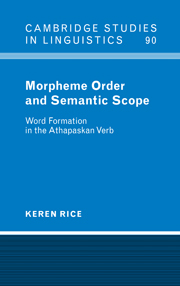1 - Introduction: Beginning the Journey
Published online by Cambridge University Press: 06 July 2010
Summary
Athapaskan languages are often thought of as the ultimate challenge by linguists interested in issues of morphosyntax, and linguists working on these languages are alternately admired and pitied. The languages have notoriously complex verb morphology, with the verb typically described as consisting of a stem and a number of prefixes, both inflectional and derivational, whose ordering is unpredictable and must be stipulated through the use of position class morphology, or a template. In addition, phonological patterning in the verb is typically also considered to be unpredictable, and some type of boundary information is built into the template. It often appears as if any generalization that one draws about morphosyntax is falsified by the verb of some Athapaskan language. As a result, the bulk of work on Athapaskan languages has taken as its primary concern aspects of verb morphology. This book represents yet another contribution to that area. It concerns a topic that has garnered much attention in Athapaskan languages, the ordering of morphemes within the verb. My contribution, as I discuss in this chapter, is to question the notion of a template as a word formation device. Instead, I propose that morpheme ordering is to a large degree regulated by principles of scope.
Consider first some of the oddities exhibited by a verb of the description in the last paragraph. First, template morphology is highly marked in languages of the world (see, for example, Myers 1987, Rice 1991, 1993, Speas 1984, 1987, 1990, 1991a, b, and, from a somewhat different perspective, Baker 1988, 1996).
- Type
- Chapter
- Information
- Morpheme Order and Semantic ScopeWord Formation in the Athapaskan Verb, pp. 1 - 6Publisher: Cambridge University PressPrint publication year: 2000



